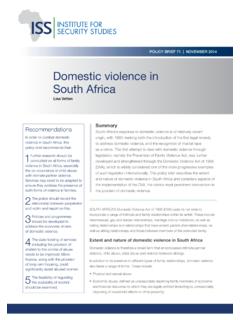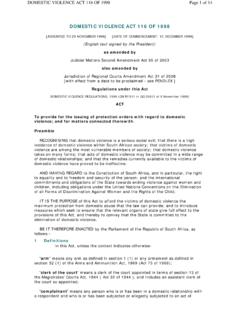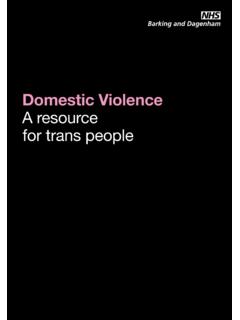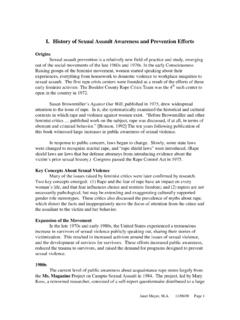Transcription of Annual South Asia Gender Summit Gender Based …
1 Annual South Asia Gender Summit Gender Based violence at Workplace 16-17th October 2014. Dhaka, Bangladesh Gender Based violence in the Workplace Nepal Introduction Nepal is gradually recovering from a decade-long civil war in which violence in Nepali society as a whole increased dramatically. During conflict, the situation of women and girls was more severe than that of their male counterparts due to Gender specific violence and inequalities exacerbated by the conflict. The challenge in this post-conflict period is to maintain a sustainable momentum in addressing all forms of violence against women and girls by ending the prevailing culture of impunity, while promoting their active involvement in the peace-building process in keeping with the commitments to promote and protect women and girls' human rights. Nepal has made strong normative and legal commitments to ending Gender - Based violence and inequality.
2 It has ratified the Convention on the Elimination of all forms of Discrimination Against women (CEDAW), thereby legally binding itself to put the CEDAW provisions into practice. Also, the General Recommendation No. 19 (Eleventh session, 1992) recommends governments to take effective measures including strong penal sanctions, civil remedies and compensatory provisions to protect women against sexual harassment in the workplace. The Beijing Platform for Action too highlights violence against women as a physical, sexual, psychological violence occurring within general community, including rape, sexual abuse, sexual harassment and intimidation at work, in educational institute etc. giving primary responsibility to the government to protect women from such violence . Despite strong commitment on the part of the government, women in Nepal continue to face various forms of Gender - Based violence (GBV), including instances of physical, sexual, psychological, socio- cultural and economic violence in private and public spheres.
3 GBV in the Work place violence can and often does follow victims and perpetrators into the workplace. Threats of violence or actual incidents of violence may occur at work, sometimes with tragic results for victims and their coworkers. Concern with Gender Based violence in the work place including sexual harassment is gradually being recognized in Nepal as a violation of human rights and an affront to the dignity of persons, which seriously undermines equality of opportunity and treatment between men and women , young and older workers. Men may be subjected to sexual harassment or other forms of Gender Based violence but majority of the victims are women . With the steady growth in the participation of women in Nepal's labor market, it may be assumed that the problem of Gender Based violence including sexual violence in the workplace is on the rise. Though there has been no major study assessing the prevalence of GBV in different workplace settings, rights activists report that more women are falling victims to sexual harassment at the workplace ranging from mere crude remarks to forced sexual relations.
4 Yet the majority of victims keep silent and the harassers go unpunished for their deeds. Though men may also be subjected to such violence several studies have revealed that the victims in most cases are predominantly women and girls. Whether it is the public, private or informal sector the problem has received little social recognition and legal redress because patriarchal values, traditions, norms and even laws discriminate against women . Furthermore, the relations between men and women are governed by norms and values that are essentially formulated by patriarchy. The long history of unequal power relations has given rise to many traditions that lead women to tolerate discrimination and exploitation. GBV in the workplace is prevalent in all workplaces whether it be the public or private sector - from government offices, UN offices, INGOs, NGOs, Media houses to private firms. However, the prevalence of GBVin the workplace is reported to be higher in the informal sector.
5 Some of the workplaces where higher occurrence of GBV and sexual violence is observed but not limited to are carpet industry, garment industry, hotels, restaurants, airlines and schools. In carpet and garment sectors, verbal sexual harassment is common, and with some exceptions, is normally accepted. In carpet factories, the work requires male and female workers to work in close physical proximity, as one handloom requires two or three workers to sit closely and work together. This encourages physical abuse. Moreover, the carpet and garment industries, due to the nature of their work, demand work-time till late hours of night. This further aggravates the problem. The prevalence of sexual harassment is equally high in the airline industry since it requires night halts in different stations. Air hostesses are often harassed in such situations by the male crew members. The hotel industry is another sector where the prevalence of sexual harassment is high.
6 In hotels, those who work in health clubs are more vulnerable to physical harassment, as women are required to massage male clients. Likewise, their male colleagues and guests harass room-maids, housekeepers and waitresses in the hotels. Saathi's experience working with women and girls working in dance bars and cabin restaurants has revealed that sexual harassment in such places is more physical. Clients harass dancers, as they grab and hug them and also use abusive language, if rejected. Dancers are also stalked and harassed on their way home. Schools constitute another sector where sexual harassment is highly prevalent. Verbal sexual harassment is common in schools. Hospitals and private clinics are also other work areas where sexual harassment takes place. Doctors ask sexual favors from the nurses. Cases have been reported of doctors harassing the patients. A study on Sexual Harassment in the Workplace in Nepal has revealed that problems of sexual harassment is highly prevalent in workplaces, as percent of women employee/workers reported that they have faced the problem of sexual harassment in their workplaces, percent of male and percent female employee/workers were of the view that they were aware of sexual harassment at the However, the problem is not brought out in the open because the subject is taboo and Nepali women still do not share the problem among friends and do not report it to authorities.
7 Initiatives Taken Some of the key initiatives undertaken by the state to address GBV and promote the rights of women and girls through policies and laws are: 1. Sexual Harassment at the Workplace in Nepal, ILO and FWLD 2004. The Interim Constitution of Nepal (2007) incorporates a separate Article (20) on the rights of women , prohibiting physical, mental or any other form of violence against women (VAW) and declares such acts as punishable by law. It also recognises women 's rights, including reproductive rights, as fundamental. The Comprehensive Peace Accord (CPA) 2006 includes a prohibitory provision on GBV, which both parties (the Seven Party Alliance and UCPN-M) to the Accord had to abide by. It contains a specific provision on the rights of women and children that relates directly to the prevention of violence against women . Domestic violence (Crime and Punishment) Act 2009 defines physical, mental, sexual, financial, as well as behavioral violence , as domestic violence .
8 The Act includes physical and psychological violence within the definition of domestic violence . Gender Equality Act, passed in 2006 repealed and amended 56 discriminatory provisions of various previous Acts and also incorporated provisions to ensure women 's rights. The Act establishes sexual violence as a crime punishable by varying years of imprisonment, depending on the age of the victim and degree of the crime committed. The Nepal Health Sector Implementation Plan 2010-2015 has outlined GBV as an integral component of health care provision. Training has been imparted to doctors, nurses, laboratory staff, nursing assistants and managers on the need to improve the Quality of Clinic (QOC). services. Protocols on management of GBV, including sexual abuse, have been developed and are now operational. The National Plan of Action Against Gender Based violence 2010 and the Five Year National Strategy and Action Plan to End Gender Based violence (2012- 2016) has committed to develop a mandatory anti GBV code of conduct for political leaders, Members of Parliament, employees of government and corporations, employees of security forces and other professionals both men and women .
9 Although a National code of conduct has not yet been developed several sectors have started taking initiative to introduce policies related to GBV in the workplace. The Ministry of Commerce and Industry has implemented a Code of Conduct, 2010 against Gender violence in workplace in industrial organizations. Similarly significant reforms have taken place in the Security Sector. The Nepal Army has issued a Gender Code of Conduct Guideline 2013 to address complaints and investigation related to Gender violence in the workplace. Similarly the Nepal Police has also developed Gender Policy as Well as GBV Code of Conduct and Armed Police Force have also taken some initiatives to introduce new Gender policies and Zero Tolerance against GBV. The government has tabled a bill on Sexual Harassment at the Workplace in parliament which is presently being discussed. The Bill has a provision for making office managements liable for preventing and controlling such harassment.
10 The bill has set out a provision under which every office should develop a mechanism for hearing complaints against sexual harassment within its premises. Trade unions have also played a role in addressing the problem of sexual harassment. In organizations where policies have not been introduced, trade unions have sometimes taken ad hoc action on receiving a complaint, and managed to achieve recognition for the problem and redress for the victim. GEFONT. (General Federation of Nepalese Trade Unions) passed a Code of Conduct on VAW in its 5th National women 's Conference held in March 2013 committing to develop the zero-tolerance culture towards violence against women in the workplaces Many NGOs are working towards creating awareness and an environment where victims can come forward with their complaints and address problems of sexual harassment. There are increasing number of NGOs who are working with women home Based workers as well as women and minors working in the entertainment sector capacitating, awaring them and where needed rescuing them from exploitative workplace and providing them alternative livelihood opportunities.





